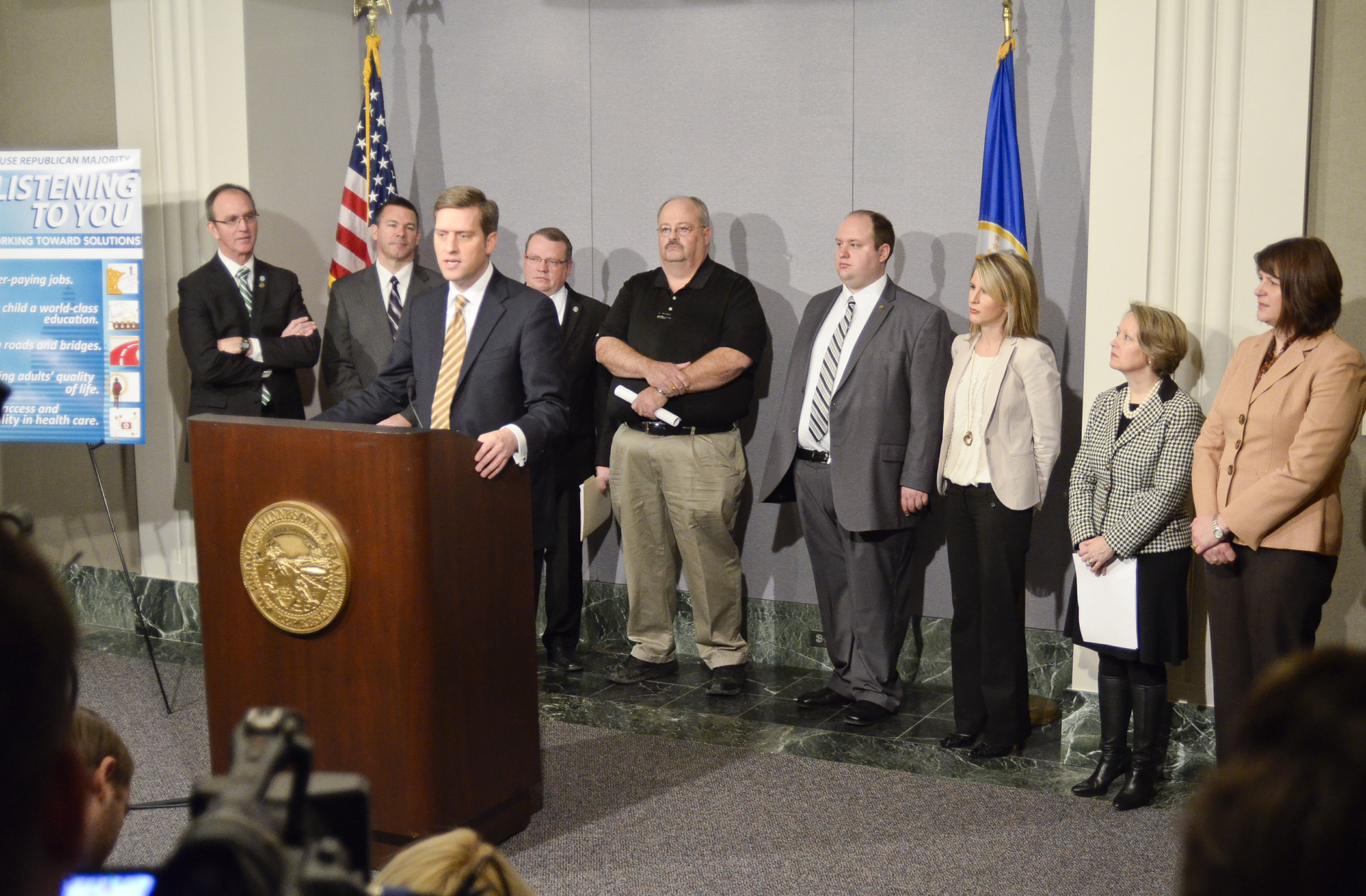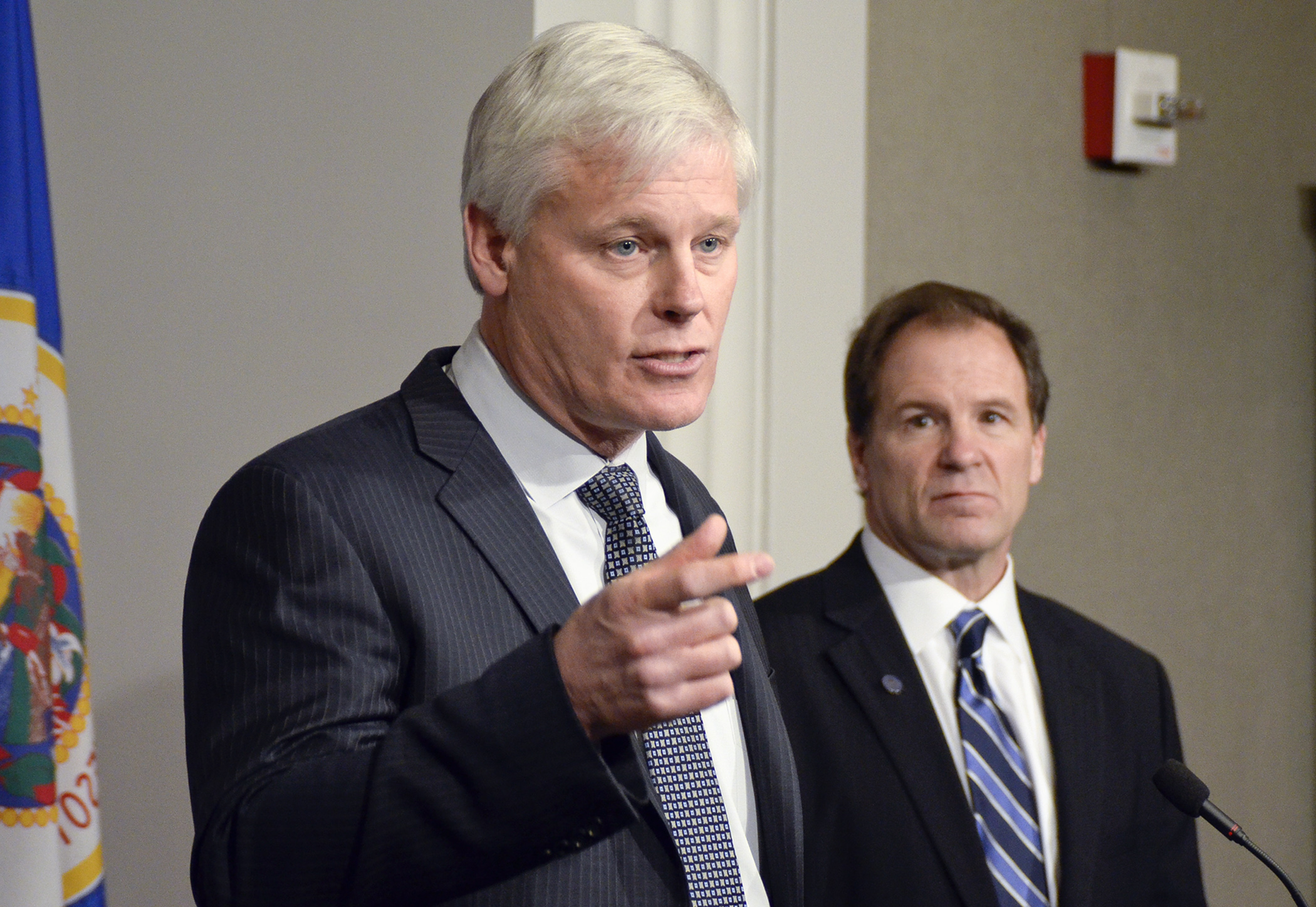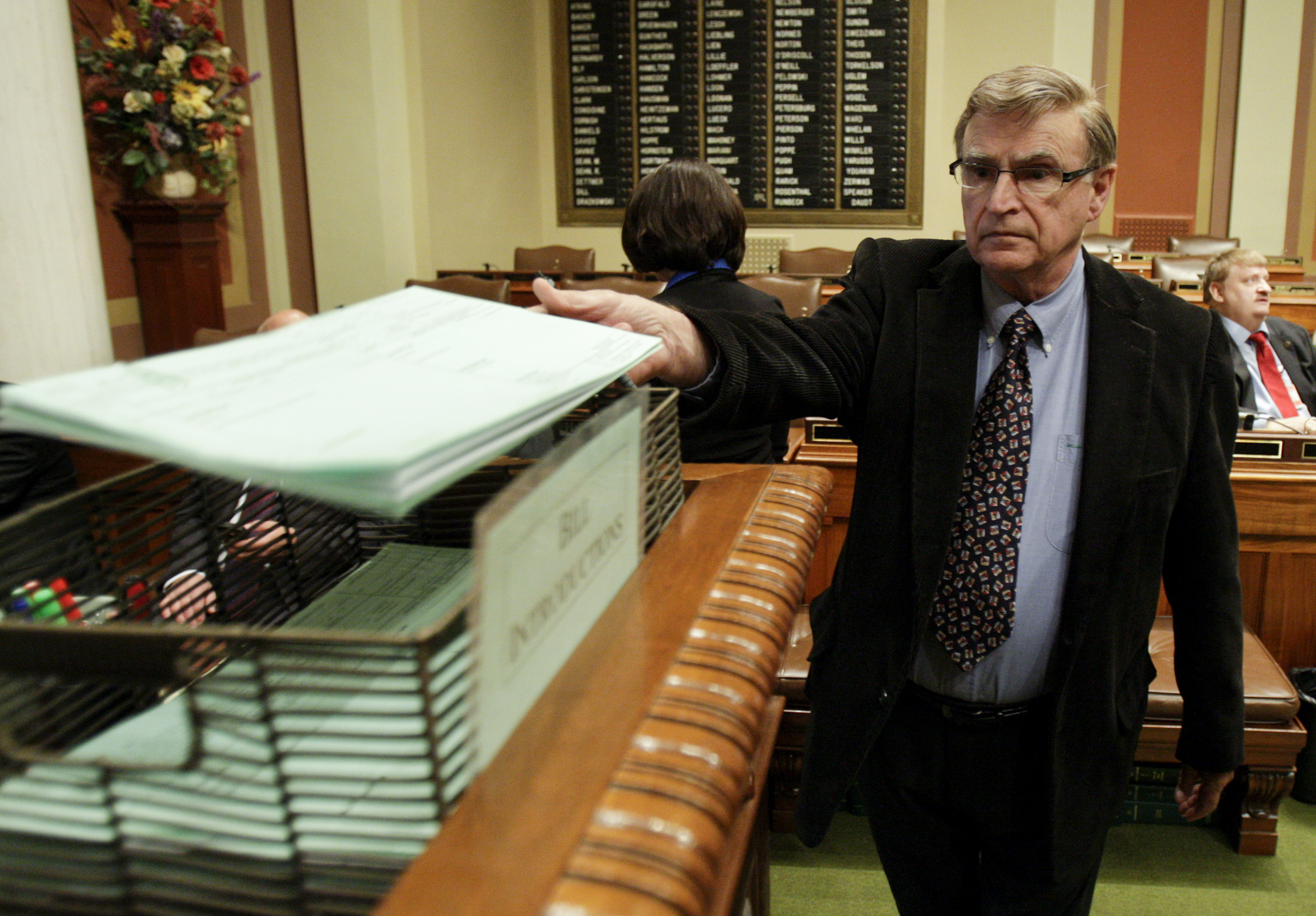First bills aim to strike balance for Greater Minnesota

Pledging to “bring some balance back to St. Paul,” House Republican leaders unveiled their first five bills of 2015 on Thursday. The initial volley of legislation puts an emphasis on Greater Minnesota issues ranging from rural employment and housing to roads and bridges.
“We felt like in the last two years, Greater Minnesota really got left behind,” House Speaker Kurt Daudt (R-Crown) said.
“I don’t want Minneapolis or St. Paul or the suburbs to feel in the next two years like they’re left behind, but we do need to understand that the dynamics of the metro area and Greater Minnesota are different. Policies affect those two areas very differently.”
The bills focused on five areas: jobs, K-12 education, elder care, transportation and health care.
Daudt emphasized that the Republican majority’s top-priority bills are works in progress, and that he expects to see provisions change through the course of the session.
“We think this really is a starting point,” he said. “We hope that with input from Minnesotans — from Democrats, from staff, from citizens — we will make these bills the best they can be.”
'Wasting an opportunity'
House Minority Leader Paul Thissen (DFL-Mpls) called the proposals inadequate.
“The reality is, right now our state is in a really good spot,” Thissen said, citing the state’s low unemployment rate and the General Fund’s $1 billion surplus.
“What it means is we have a great opportunity right now to do really good things for Minnesota and to build for our long-term future. What I see in the Republican proposals is a waste of that opportunity. It’s giveaways to rich Minnesotans and to corporations and it’s short-term Band-Aids for things that even [Republicans] on the campaign trail said we need long-term solutions for.”
Tax credits
The centerpiece of HF1 is a series of tax credits aimed at spurring job creation. According to sponsor Rep. Ron Kresha (R-Little Falls), a New Market Tax Credit would create special incentives for investment in the manufacturing, timber, mining and high-tech sectors. Other tax provisions proposed in the bill would:
- expand the research and development tax credit by making it refundable for the first $2 million in qualifying investment and increase the credit on investments over $2 million to 4 percent;
- create a refundable credit on income taxes for people who earn their degrees and take jobs in science, technology, engineering or mathematics (STEM) or in long-term health care occupations; and
- provide a 10 percent exclusion of S-corporation pass-through income from state income taxes.
The bill also proposes a series of regulatory reforms.
It seeks to reduce the targeted turnaround time for environmental permits from 90 days to 45. And it proposes allowing the Legislative Coordinating Commission to object to state agency rules that fall outside an agency’s purview or stand to adversely affect the economy or consumers. The bill would also require that the proceeds from financial penalties imposed by state agencies be deposited in the General Fund.
Another provision aims to address the shortfall of viable employee housing stock in some Greater Minnesota areas. It proposes $5 million to construct workforce rental housing in communities with populations above 1,500 and businesses with more than 20 employees that are facing difficulties with workforce housing.
Teacher tuneups
As expected, Republican leaders have made merit-based teacher retention policies for school districts one of their top K-12 education legislative priorities.
HF2, sponsored by Rep. Jenifer Loon (R-Eden Prairie), would allow school districts greater flexibility in using annual teacher evaluations along with seniority as a measuring stick if/when decisions are made to cut teaching staff. A 2011 law mandates annual teacher evaluations, and Loon said HF2 would further ensure all students have access to the highest quality teachers.
 House Minority Leader Paul Thissen and Rep. Paul Marquart provide a DFL response after House Republicans unveiled the first five bill introductions for the 2015 session. Photo by Andrew VonBank
House Minority Leader Paul Thissen and Rep. Paul Marquart provide a DFL response after House Republicans unveiled the first five bill introductions for the 2015 session. Photo by Andrew VonBank“It’s important that we are on a system of continuous improvement and we know that next to parent involvement the most important factor in the successful education of all our children is quality teachers,” said Loon, who chairs the House Education Finance Committee. “We’re going to take that evaluation system and say that if the schools are in the difficult situation of having to make a reduction in our teaching force, those evaluations that measure teacher performance will be part of the process.”
Rep. Paul Marquart (DFL-Dilworth) characterized the proposal as a disappointing first effort by Republicans to invest in education.
“I don’t see going after hardworking teachers as the approach to do this,” Marquart said. “Evaluations are important; making sure we have the best teachers in classroom (is) important. That’s already being done right now.”
HF2 also would streamline the process for out-of-state teacher licensure and increase flexibility for school districts to hire local community experts to provide vocational career and technical classes to high school students.
Health care continuity and new savings accounts
Sponsored by Rep. Joe Schomacker (R-Luverne), HF3 is intended to encourage health-care workers to make a career out of their jobs.
“We know that if people stay in that care position long enough that that adds continuity to the care that our seniors get,” he said.
The bill would:
• expand the student loan forgiveness program for certain health care professionals;
• encourage state workforce centers to better train workers to fill long-term care facility openings; and
• expand scholarship opportunities for newly-hired health care workers to help them pay down their student loan debt. The scholarships could be used to help pay for daycare or transportation costs, according to Schomacker, who said the goal is to make careers out of health care jobs that are a revolving door today.
The bill’s second objective is to encourage people to plan for their long-term health care needs by offering tax credits to those who put money away in a long-term savings account. Non-retirees who already have long-term care costs would receive a tax credit to offset an early withdrawal penalty when they use their savings, such as IRAs, to pay for long-term care.
 Rep. Bud Nornes drops a bill in the “hopper” before session Thursday Jan. 8. Photo by Paul Battaglia
Rep. Bud Nornes drops a bill in the “hopper” before session Thursday Jan. 8. Photo by Paul Battaglia“We want to offer a tax credit in order to offset the cost of that tax penalty so people are able to use their own money to make their own decisions and have their own choices,” said Schomacker, chair of the House Aging and Long-Term Care Policy Committee.
Thissen said that, while nice to do, it won’t solve the problem that DFLers worked on by raising health care worker’s wages in the previous biennium.
“We know, as the Republicans know, as everybody knows, that there’s a challenge out there for attracting really good workers and keeping really good workers in long-term care facilities.”
A refocus on roads, but no new taxes
The Republican majority has placed its transportation focus squarely on Minnesota’s maintenance-starved roads and bridges with $750 million in additional proposed spending.
But with $6 billion in projected needs over the next decade — and no new revenue proposed to tackle those — critics argued Thursday the plan presents a short-term fix.
Billed as a refocus on roads and bridges, HF4, sponsored by Rep. Tim Kelly (R-Red Wing), proposes to use $505 million in existing unreserved Department of Transportation dollars, $200 million of the state’s projected billion-dollar surplus and would require MnDOT to find up to $65 million in savings within its existing 2014-2015 budget.
Kelly, chair of the House Transportation Policy and Finance Committee, said the plan would mark an infusion of much-needed funds without raising taxes.
“We need to reinvest in our infrastructure,” he said.
Thissen accused House Republicans of “waiving the white flag” on finding a broader transportation funding solution.
“$750 million over four years is not even a Band-Aid,” Thissen said.
Kelly’s bill differs widely from a funding plan Gov. Mark Dayton pitched Jan. 7 that calls for increases in the statewide gas tax for roads and bridges, and a metro-area sales tax to fund transit projects.
House and Senate transportation leaders were unable last year to pass similar legislation, citing a lack of support from Republicans and the state’s business leaders.
Ensuring the insured have options
HF5 would request that by July 1, 2015, the Patient Protection and Affordable Care Act allow Minnesota to offer more health insurance purchasing options outside the MNsure market — Minnesota’s public health insurance exchange — while still qualifying for current federal tax credits.
“Our goal, of course, being that everybody has equal and good access to good quality health care including keeping their own doctors and getting the best price available to them and their families,” said the bill’s sponsor, Rep. Tara Mack (R-Apple Valley).
Mack also seeks to shore up holes in MNsure’s administration to ensure more checks and balances.
“It was created as a super agency that was exempt from many of the other requirements that other departments are expected to deliver on,” Mack said.
The bill would:
• add MNsure’s executive director to the list of state employees with salary limits of 133 percent of the governor’s salary;
• remove some of the open meeting law exemptions; and
• require salary ranges within an approved managerial plan beginning July 1, 2015.
Previous session first bill introductions
2013: School district current year aid payment shift percentage restored to 90.
2011: Environmental permitting efficiency provided, and environmental review requirements modified.
2009: State partnership created with federal efforts to restore the American economy, federal Economic Rescue and Recovery Act supplemented.
2007: Children's health security account and program created, eligibility criteria and covered services specified, Legislative Task Force on Children's Health Care Coverage established.
2005: Omnibus public safety finance bill … and requiring life sentences for specified sexual assault crimes.
2003: Anti-terrorism; driver's license information regulation provided including proof of identity and residency, and federal laws and regulations adopted.
2001: Individual income tax and alternative minimum tax rates reduced.
(HPIS staff writers Jon Avise, Sue Hegarty, Hank Long and Steve Perry contributed to this story)
Related Articles
Search Session Daily
Advanced Search OptionsPriority Dailies
Ways and Means Committee OKs proposed $512 million supplemental budget on party-line vote
By Mike Cook Meeting more needs or fiscal irresponsibility is one way to sum up the differences among the two parties on a supplemental spending package a year after a $72 billion state budg...
Meeting more needs or fiscal irresponsibility is one way to sum up the differences among the two parties on a supplemental spending package a year after a $72 billion state budg...
Minnesota’s projected budget surplus balloons to $3.7 billion, but fiscal pressure still looms
By Rob Hubbard Just as Minnesota has experienced a warmer winter than usual, so has the state’s budget outlook warmed over the past few months.
On Thursday, Minnesota Management and Budget...
Just as Minnesota has experienced a warmer winter than usual, so has the state’s budget outlook warmed over the past few months.
On Thursday, Minnesota Management and Budget...